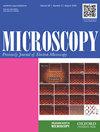A simple preparation method for CLEM using pre-embedding immunohistochemistry with a novel fluorescent probe and stable embedding resin
IF 1.8
4区 工程技术
引用次数: 0
Abstract
Correlative light and electron microscopy (CLEM) is an excellent approach for examining the cellular localization of biomolecules. Here, we developed a simple method for CLEM by combining pre-embedding immunohistochemistry with a novel fluorescent probe, namely Fluolid NS Orange, and an embedding resin called ʻDurcupan ™ ʼ. Specimens were embedded in Durcupan ™ or LR White after immunolabeling and post-fixation using glutaraldehyde and osmium tetroxide. Next, ultrathin sections were prepared on a finder grid with navigation markers. The section of the specimen embedded in Durcupan ™ was found to be more stable against electron beam irradiation than specimens embedded in LR White. A fluorescence light microscopy image and a transmission electron microscopy (TEM) image, at wide-field, and low magnification, were independently obtained with the same ultrathin section. Using the three corners between finder grid bars as landmarks, fluorescence light microscopy images were superimposed with wide-field, low-magnification TEM images to identify the region of interest, which was subsequently enlarged to ascertain cellular structures localized beneath fluorescent signals. However, the enlarged TEM images appeared blurred, and fluorescence signals had a hazy appearance. To resolve this, the enlarged TEM images were replaced by high-resolution TEM images focused directly on the region of interest, thereby facilitating the collection of high-resolution CLEM images. The simple sample processing method for CLEM using osmium-resistant Fluolid NS Orange and electron beam damage-resistant Durcupan™ allowed the determination of the precise localization of fluorescence signals at subcellular levels.新型荧光探针和稳定包埋树脂预包埋免疫组化制备CLEM的简便方法
相关光学和电子显微镜(CLEM)是检测生物分子细胞定位的一种极好的方法。在这里,我们开发了一种简单的CLEM方法,将预包埋免疫组织化学与一种新型荧光探针,即Fluolid NS Orange和一种称为Durcupan的包埋树脂相结合™。样本嵌入杜库潘™ 或免疫标记和使用戊二醛和四氧化锇固定后的LR White。接下来,在带有导航标记的取景器网格上制备超薄切片。嵌入杜库潘的标本剖面™ 被发现对电子束照射比嵌入LR White中的样品更稳定。在宽视场和低放大率下,用相同的超薄切片独立获得荧光显微镜图像和透射电子显微镜(TEM)图像。使用取景器栅条之间的三个角作为标志,将荧光显微镜图像与宽视场、低放大率的TEM图像叠加,以识别感兴趣的区域,随后对其进行放大,以确定位于荧光信号下方的细胞结构。然而,放大的TEM图像看起来模糊,并且荧光信号具有模糊的外观。为了解决这个问题,将放大的TEM图像替换为直接聚焦在感兴趣区域上的高分辨率TEM图像,从而便于收集高分辨率CLEM图像。使用耐锇Fluolid NS Orange和耐电子束损伤Durcupan的CLEM的简单样品处理方法™ 允许在亚细胞水平上确定荧光信号的精确定位。
本文章由计算机程序翻译,如有差异,请以英文原文为准。
求助全文
约1分钟内获得全文
求助全文
来源期刊

Microscopy
工程技术-显微镜技术
自引率
11.10%
发文量
0
审稿时长
>12 weeks
期刊介绍:
Microscopy, previously Journal of Electron Microscopy, promotes research combined with any type of microscopy techniques, applied in life and material sciences. Microscopy is the official journal of the Japanese Society of Microscopy.
 求助内容:
求助内容: 应助结果提醒方式:
应助结果提醒方式:


